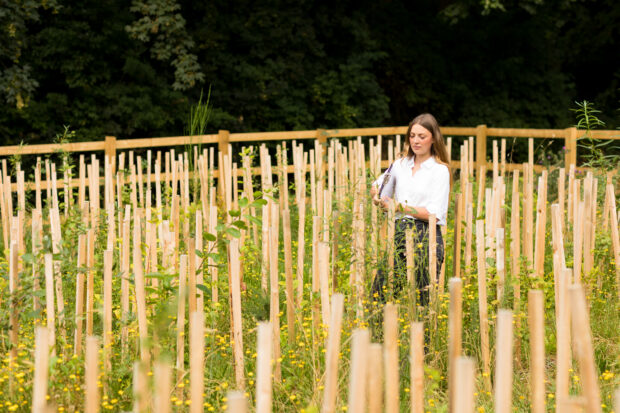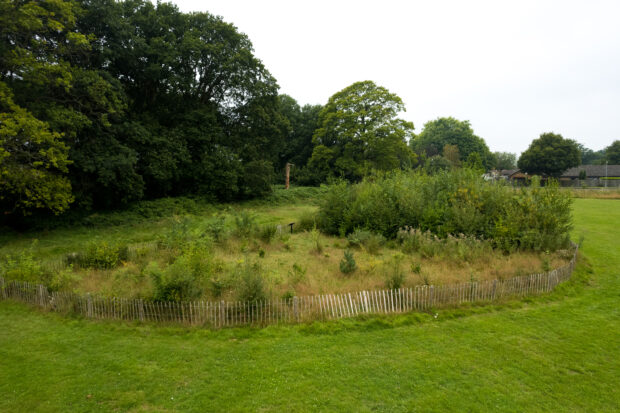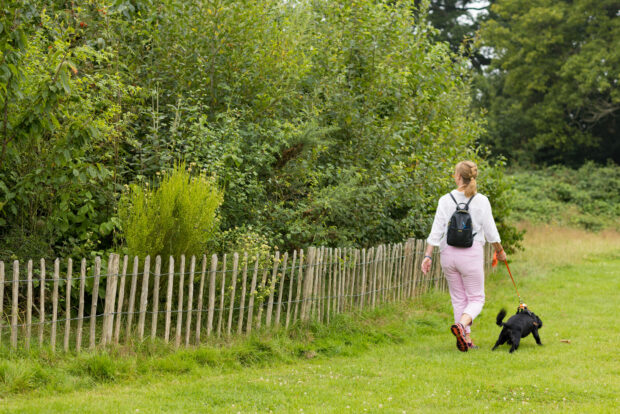
By Louise Butfoy, Trees Outside Woodland Project Officer, Kent Country Council
As a Project Officer at Kent County Council, I’ve been working on the Trees Outside Woodlands project since its inception in October 2020. The project is funded by HM Government’s Shared Outcomes Fund. It is a £4.8m, 5-year, programme delivered in partnership with The Tree Council, Natural England, Defra, and five local authorities. My day-to-day role ranges from planning new experimental planting schemes, collaborative projects within the county, conducting site visits, speaking to the community and the various project partners, to monitoring and evaluating our pilots.
I have always had a passion for nature, which motivated me to seek a career in this field. It has provided me with the opportunity to be able to experiment and try out novel approaches in tree planting and management, with the aim of increasing our tree cover across the county. We’ve now reached the stage where, excitingly, we can start sharing the results of some of our pilots.
Trees in urban areas can be difficult to establish: vandalism, a lack of local authority resources for aftercare, competition for space, extreme weather conditions and inhospitable landscapes are just a few of the challenges.
Stresses on newly planted urban trees can result in low survival rates, preventing these trees from providing their potential ecosystem services, and creating the perception that planting in such locations is unreliable and costly. There are many benefits for both people and nature that urban trees provide, which is why experimentation and new approaches need to be explored more often.
In 2020, we began to hear news of a tree planting method from Japan that was gaining traction across Europe. The method was being used to quickly establish small pockets of woodland in urban green spaces.
Learning about some of the recent successes, we decided through the collaborative Trees Outside Woodlands project to investigate the use of this method in a UK local authority context. This was to understand whether it could be a cost effective and reliable new approach to successfully establish urban trees, maximising their ecosystem services.

The Miyawaki Method
The Miyawaki methodology is based on a woodland establishment and management approach, developed by Japanese botanist Dr Akira Miyawaki. The aim is to quickly reconstruct indigenous woodlands on deforested land or areas with degraded soils. The method has been successfully utilised in Asia for over 50 years for the purpose of environmental conservation, water retention, and protection against natural hazards.
The method involves densely planting a wide selection of native tree and shrub species suited to the site, into aerated, enriched soil, mulching and then maintaining the plot for two to three years, from which point minimal interventions should be made.
Our Trials
The wider £4.8m Trees Outside Woodland programme is developing innovative and sustainable new ways to increase tree cover, to address both climate and ecological emergencies.
As part of this we planted 16 urban experimental Miyawaki method plots adjacent to comparison plots, using standard local authority planting methods across four English local authorities. Sites were chosen for their record of past planting failure and the poor quality of their soils.
Paired experimental and comparison plots used tree whips comprising the same species mix, grown from the same nurseries, and were equally maintained through the first three years following planting.

The Results
Initially, the total cost to plant a plot using the Miyawaki method was higher compared to the comparison plots. This is because it’s a more resource heavy process, requiring around three times the number of trees to be planted. However, our findings so far show a significantly greater survival rate in the Miyawaki plots (an average of 79%) compared to the comparison plots (47%). This was achieved during a drought in summer 2022.
The average median cost of the Miyawaki method was £10 per survived tree, against £50 for standard practice planting methods. This is because a much higher proportion of the planted trees in the Miyawaki plots survived, compared to the control plots. Results have also shown much less cost variability per surviving tree in the Miyawaki plots, suggesting it’s easier to predict how much it will cost to get a number of trees surviving for the first three years using the Miyawaki method than typical techniques.
In addition to this, growth rates have been higher across the Miyawaki plots, after three and a half years the trees generally resemble a dense thicket of early successional woodland, in fact some of the biggest trees are about 15 feet tall. All species are thriving, some are faster growing than the others, many are flowering and producing seed already, and wildlife is making a home within the plot. Most of the surviving trees in the comparison areas are also doing well, but they tended to be significantly smaller than those in the Miyawaki plots, and some were also vandalised.
We have found that although urban tree planting can be difficult and costly, adapting the Miyawaki method appropriately to suit the challenges of individual urban sites can be an effective way to establish trees.

The Future
We don’t yet know what our experimental plots will look like in the long term. Across Asia, large areas planted using the Miyawaki method are 50 years old and are healthy woodlands with mixed canopy levels. Even if our small plots provide only 3 or 4 mature trees eventually, in the meantime they will have provided an instant impact feature with benefits for biodiversity and local people.
Since 2023, we’ve been testing different elements of the Miyawaki method, to see if any individual aspect is having a particular effect. This will allow us to understand if we can still produce high survival and growth rates, but reduce the initial cost of the method, and perhaps reduce the disturbance to the soil.
There will be situations where all the elements of the method are not necessary, so we wanted to see if we could break it down without losing the benefits we’ve observed to date.
We are continuing to monitor our trial plots, and we hope that our work will inspire further research into this evolving planting approach, which so far, looks to provide us with a great way to quickly build small habitats for recovering nature, which in turn, benefits the lives and wellbeing of communities within the area.
More information on this pilot and the wider project can be found on our website.
You can also read the published report here.
Watch our video to learn more:
2 comments
Comment by Barney Green posted on
Excellent work and an enjoyable and hopeful read with my morning coffee! This after reading in The Guardian of the Bison Bridge being built as part of the successful reintrorduction of European Bison to Kent. The county making great strides and interested to see such initiatives being replicated country-wide although I know we also doing much good work here in East Sussex too where I a local footpath warden and Forest School Leader in training. Sharing this on the socials in the hope more jump on board with following and supporting such great work. Have a good w/e.
Comment by Kim Turner posted on
Fantastic experiment which will benefit so many urban areas of Britain that miss out on wildlife at present . Best of luck . I love the initiative
Regards Kim Turner